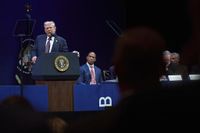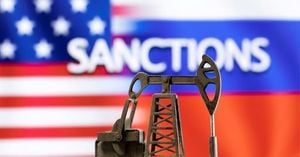As the United States enters the fall of 2025, a wave of new federal policies is reshaping the landscape for young people, artists, and LGBTQIA+ communities. Two recent developments—the tightening of the Teen Pregnancy Prevention Program (TPPP) and the National Endowment for the Arts’ (NEA) controversial funding restrictions—have ignited fierce debate over free speech, public health, and the role of ideology in government programs. At the heart of these changes lies a fundamental question: whose voices and values shape American life, and at what cost?
According to reporting published on September 8, 2025, the TPPP, a nationwide, evidence-based initiative created by Congress in 2010, has been instrumental in driving down teen birth rates. In its first five years, the program helped reduce teen births by 35 percent, from 34 per 1,000 girls in 2010 to 22 per 1,000 in 2015. By 2023, the rate had dropped to a historic low of 13.1 per 1,000 girls—a success story by any measure. Yet this summer, the U.S. Department of Health and Human Services (HHS) issued a new policy that critics say could undermine the very progress TPPP was designed to achieve.
Under the revised guidelines, organizations seeking TPPP grants—ranging from universities and nonprofits to state health departments and Planned Parenthood affiliates—must now agree to a series of ideological stipulations. These include affirming the “immutable biological reality of sex,” rejecting so-called “radical gender ideology,” and pledging not to promote “anti-American ideologies such as discriminatory equity ideology.” Grantees are also required to inform parents of any programs that “may burden their religious exercise.”
For many advocates, these requirements represent a sharp turn away from the evidence-based, inclusive approach that made TPPP effective. “Young people are getting the message loud and clear: Religious ideology takes precedence over their health, well-being and rights,” the article notes, highlighting a growing sense of frustration among public health experts and youth advocates.
The debate over sex education in America is hardly new. Comprehensive sex education (CSE), which covers topics from STI prevention to healthy relationships and gender identity, has long been supported by research as a way to empower young people with information and life skills. Yet, as of 2025, only 13 states require CSE, while many others offer abstinence-only education or none at all. In roughly half of U.S. states, students lack access to accurate, age-appropriate sex education, leaving them to piece together information from unreliable sources.
Abstinence-only programs, first popularized during the Reagan administration, have been rebranded as “sexual risk avoidance education,” but critics argue they reinforce stigma and deprive young people of the knowledge they need to make safe choices. The new TPPP mandates, coupled with attacks on Title X and Planned Parenthood funding, are viewed by many as part of a broader trend that prioritizes religious doctrine over science and public health.
These policy shifts have real-world consequences. If organizations refuse to comply with the new restrictions, they risk losing critical funding. Vulnerable youth—especially pregnant and parenting teens—may find themselves cut off from support. The impact is particularly acute for LGBTQIA+ youth, who already face heightened risks and whose identities are often targeted by these new rules. “This is especially true for LGBTQIA+ youth, whose very existence new policies seek to deny,” the article observes.
Meanwhile, the cultural sector is grappling with its own version of this ideological battle. At the start of 2025, the NEA imposed a requirement that grant applicants certify they would not use federal funds to “promote gender ideology,” effectively barring projects that explore issues of gender identity and LGBTQ+ themes. The American Civil Liberties Union (ACLU) swiftly filed suit, representing organizations like the National Queer Theater (NQT), which lost a $20,000 grant for its 2025 Criminal Queerness Festival—a program previously funded by the NEA in 2023 and 2024.
Adam Odsess-Rubin, NQT’s founding artistic director, described the move as “really just part of a more pervasive backlash against the trans community for just standing up for basic civil rights and basic representation.” In a conversation with Tim Miller—one of the famed NEA Four, a group of performance artists whose grants were rejected in the 1990s for controversial work—Odsess-Rubin emphasized the chilling effect these policies have on the arts. “We celebrate all gender identities, all gender expressions, and that’s a fundamental part of our work as queer artists,” he said.
The NEA Four’s legal battle in the 1990s resulted in a Supreme Court decision upholding a “decency” requirement for arts funding, but Miller sees today’s environment as far more severe. “At first, our current catastrophe felt like familiar terrain. OK, this is like the NEA Four case in the 90s Culture War. But as this has gone on, it’s gotten so much more draconian,” Miller reflected. “As the NEA Four becomes the NEA 400 with all these grants taken away, and almost every program head at the NEA has resigned, the main difference is it’s so much worse right now.”
Artists and organizations are responding with creativity and resilience. Odsess-Rubin recounted stories of artists worldwide finding ways to subvert censorship—from staging secret performances in Kenya to changing pronouns in plays in Lebanon. Yet in the United States, he warns, the chilling effect is palpable: “There’s this pervasive chilling effect where theaters are programming less queer art, creating less opportunities for queer artists, and people are complying in advance, which is exactly what we’re not supposed to do to allow fascism to continue to spread in our society.”
For Miller, the stakes are deeply personal. “I think we just need to dig as deep as we can, continue to claim agency over our lives, over our sexuality, over our bodies, bravely and energetically, and do not let this coercion win by self-censoring.” Odsess-Rubin echoes the urgency, reminding readers, “If we allow ourselves to censor ourselves and censor each other, we’re basically giving up that right, and it’s a scary path.”
These battles over education, health, and the arts are not occurring in a vacuum. They are part of a broader set of policies that have targeted gender-affirming care for youth—now severely limited or banned in most states—and prompted federal investigations into school districts that allow transgender students to participate in sports or use restrooms aligned with their gender identity. As Adam Odsess-Rubin puts it, “Arts is just one manifestation of this attack. You can look at bathroom bills, you can look at attacks on gender affirming care, you can look at bans on trans people in the military.”
As the school year begins, and as artists prepare for another season of creativity and resistance, the message from both the health and cultural sectors is clear: the fight over who gets to speak, create, and thrive in America is far from over. The outcome will shape not just policy, but the very fabric of American society for years to come.




